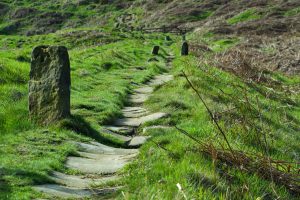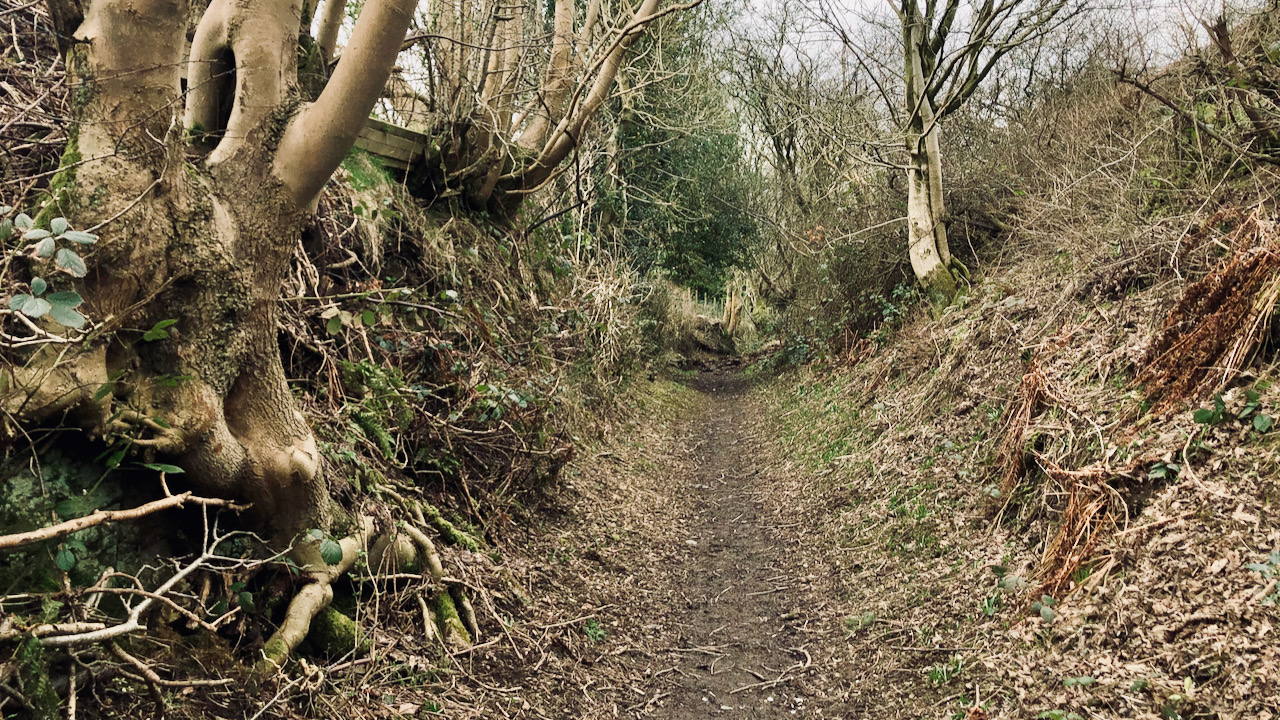Taking a respite from the biting easterly breeze while in the shelter of Cold Moor Lane, a sunken bridleway climbing out of Chop Gate, a debate unfolded about its origins1Hollow way and trod named Cold Moor Lane NYM HER No: 11616..
Well, if we concede that its sunken characteristic stems from centuries of human and animal movement along this route, then I suppose one could argue it’s manmade. Although I doubt it was intentionally constructed.
Later, as I climbed Cold Moor, my mind wandered, contemplating the nature of the traffic on this beaten track. Who were its users? It seemed to be merely leading towards the rather narrow ridge. Sleds carrying peat turves and heather bales being dragged down would have undoubtedly contributed to the erosion. But that was a seasonal affair. Who or what else?
And then, as I perused the map, it dawned on me. The path, the modern Public Bridleway, aligns directly to the summit of Kirby Bank with its medieval trod2Kirkby Bank trod NYM HER No: 17931.. The ridge boasts only a 50-metre height difference from the col at Donna Cross, offering a more direct route than descending into Raisdale, which, in medieval times, might likely have been wooded and boggy.

Kirby Bank and its trod would have certainly witnessed heavy usage by the “Panniermen,” the term most commonly associated with long-distance goods haulage across the North York Moors. On these arduous treks, one or two Panniermen would lead a train of 12 to 40 packhorses. The lead horse carried a bell to signal the approach of the train. Each horse sported a pair of wicker panniers, the design varying according to the cargo. Ordinary baskets carried fish or wool, while heavy loads like coal or stone had hinged bottoms for easy unloading. The packhorses were Cleveland Bays—smaller and less refined than their modern counterparts, yet possessing a calm temperament and impressive strength, versatility, and stamina.
The Cistercian Monks at Rievaulx Abbey played a pivotal role in the trade route’s economic landscape. Adhering to a vegetarian diet except for fish on Fridays, the Abbey acquired riverside fisheries along the River Tees. To ensure the fish reached the Rievaulx kitchens in an edible state, the monks employed trains of packhorses. These trusty steeds also transported vital salt stocks from the Abbey’s salt pans, situated north of the Tees. Bred and owned by the Abbey, the horses found lodging at their numerous granges.
These sunken lanes, or holloways, are ancient fixtures of the English countryside. Shaped by centuries of use, they are found in areas with soft rock and slopes. Originally trodden by both people and animals, these paths gradually deepened over time. The term “holloway” traces its roots to the Old English “hola weg,” literally translating to ‘sunken road.’
Holloways have wielded substantial influence throughout history. Serving as indispensable travel routes, they connected villages, markets, and religious sites. Additionally, they demarcated land boundaries and facilitated the safe transit of livestock. The sunken aspect of these pathways is a consequence of both human activity and erosion. They are more than just physical features; they represent a link to bygone eras. Offering a glimpse into medieval existence, holloways underscore the significance of these routes in the social and economic life.
- 1Hollow way and trod named Cold Moor Lane NYM HER No: 11616.
- 2Kirkby Bank trod NYM HER No: 17931.

Leave a Reply